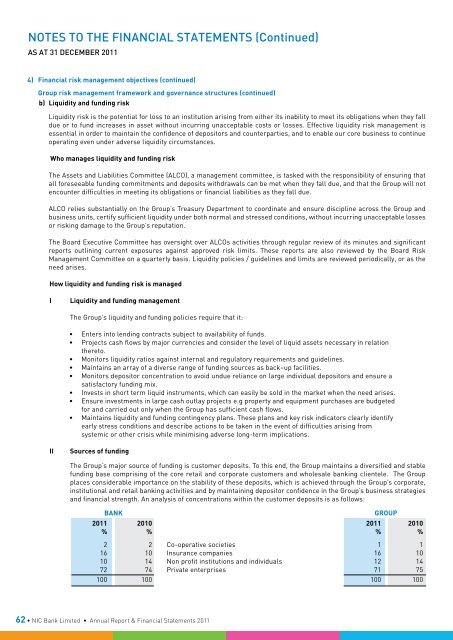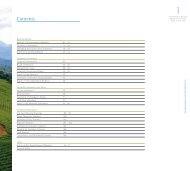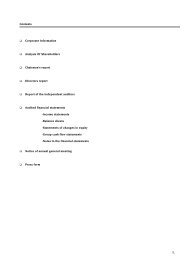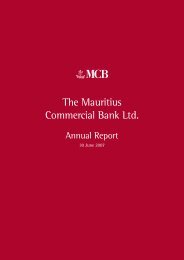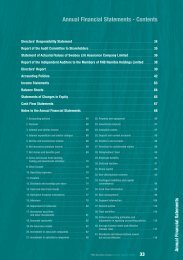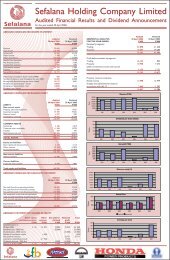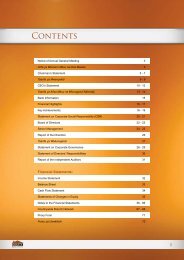Financial Statements 2011 - Investing In Africa
Financial Statements 2011 - Investing In Africa
Financial Statements 2011 - Investing In Africa
You also want an ePaper? Increase the reach of your titles
YUMPU automatically turns print PDFs into web optimized ePapers that Google loves.
Notes To The <strong>Financial</strong> <strong>Statements</strong> (Continued)<br />
As at 31 december <strong>2011</strong><br />
4) <strong>Financial</strong> risk management objectives (continued)<br />
Group risk management framework and governance structures (continued)<br />
b) Liquidity and funding risk<br />
Liquidity risk is the potential for loss to an institution arising from either its inability to meet its obligations when they fall<br />
due or to fund increases in asset without incurring unacceptable costs or losses. Effective liquidity risk management is<br />
essential in order to maintain the confidence of depositors and counterparties, and to enable our core business to continue<br />
operating even under adverse liquidity circumstances.<br />
Who manages liquidity and funding risk<br />
The Assets and Liabilities Committee (ALCO), a management committee, is tasked with the responsibility of ensuring that<br />
all foreseeable funding commitments and deposits withdrawals can be met when they fall due, and that the Group will not<br />
encounter difficulties in meeting its obligations or financial liabilities as they fall due.<br />
ALCO relies substantially on the Group’s Treasury Department to coordinate and ensure discipline across the Group and<br />
business units, certify sufficient liquidity under both normal and stressed conditions, without incurring unacceptable losses<br />
or risking damage to the Group’s reputation.<br />
The Board Executive Committee has oversight over ALCOs activities through regular review of its minutes and significant<br />
reports outlining current exposures against approved risk limits. These reports are also reviewed by the Board Risk<br />
Management Committee on a quarterly basis. Liquidity policies / guidelines and limits are reviewed periodically, or as the<br />
need arises.<br />
How liquidity and funding risk is managed<br />
I<br />
Liquidity and funding management<br />
The Group’s liquidity and funding policies require that it:<br />
• Enters into lending contracts subject to availability of funds.<br />
• Projects cash flows by major currencies and consider the level of liquid assets necessary in relation<br />
thereto.<br />
• Monitors liquidity ratios against internal and regulatory requirements and guidelines.<br />
• Maintains an array of a diverse range of funding sources as back–up facilities.<br />
• Monitors depositor concentration to avoid undue reliance on large individual depositors and ensure a<br />
satisfactory funding mix.<br />
• <strong>In</strong>vests in short term liquid instruments, which can easily be sold in the market when the need arises.<br />
• Ensure investments in large cash outlay projects e.g property and equipment purchases are budgeted<br />
for and carried out only when the Group has sufficient cash flows.<br />
• Maintains liquidity and funding contingency plans. These plans and key risk indicators clearly identify<br />
early stress conditions and describe actions to be taken in the event of difficulties arising from<br />
systemic or other crisis while minimising adverse long-term implications.<br />
II<br />
Sources of funding<br />
The Group’s major source of funding is customer deposits. To this end, the Group maintains a diversified and stable<br />
funding base comprising of the core retail and corporate customers and wholesale banking clientele. The Group<br />
places considerable importance on the stability of these deposits, which is achieved through the Group’s corporate,<br />
institutional and retail banking activities and by maintaining depositor confidence in the Group’s business strategies<br />
and financial strength. An analysis of concentrations within the customer deposits is as follows:<br />
Bank<br />
Group<br />
<strong>2011</strong> 2010 <strong>2011</strong> 2010<br />
% % % %<br />
2 2 Co-operative societies 1 1<br />
16 10 <strong>In</strong>surance companies 16 10<br />
10 14 Non profit institutions and individuals 12 14<br />
72 74 Private enterprises 71 75<br />
100 100 100 100<br />
62 • NIC Bank Limited • Annual Report & <strong>Financial</strong> <strong>Statements</strong> <strong>2011</strong>


